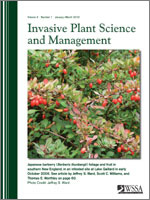Broadleaf herbicides are commonly used to suppress exotic weeds with the intent of releasing native species from negative impacts of invasion. However, weed control measures can also have unintended consequences that should be considered along with intended effects. We conducted a controlled field experiment within bunchgrass communities of western Montana to examine if broadcast application of the broadleaf herbicide, picloram, may mitigate impacts of the exotic forb, spotted knapweed, on the dominant native grass, bluebunch wheatgrass, and forb, arrowleaf balsamroot. Local-scale relationships between native species and spotted knapweed cover served as a baseline for evaluating treatment effects at differing spotted knapweed invasion levels. To examine secondary invasion, we also measured treatment effects on the exotic grass, downy brome, relative to initial levels of spotted knapweed cover. Picloram application suppressed spotted knapweed cover by 70 to 80%. Treatment appeared to release cover and seed production of bluebunch wheatgrass, causing increases that varied positively with initial spotted knapweed cover. Bluebunch wheatgrass measures were elevated by as much as fourfold in treated vs. control plots, exceeding baseline levels in noninvaded plots. For arrowleaf balsamroot, negative effects of treatment prevailed, particularly where initial spotted knapweed cover was low. Arrowleaf balsamroot cover and fecundity variables were reduced by as much as 60% in treated vs. control plots, to levels typifying baseline conditions in highly invaded plots. In addition, treatment released downy brome, with cover increases from 2- to 20-fold. A controlled experiment selectively removing spotted knapweed showed similar release of downy brome. Our results show that picloram effects can depend on initial levels of weed invasion and may include substantial side effects, particularly when broadcast applications are used. Integrated approaches that include seeding of desirable species may be needed to enhance plant community resistance to secondary invaders and reinvasion by the target weed.
Nomenclature: Picloram; downy brome, Bromus tectorum L. BRTE; spotted knapweed, Centaurea stoebe L. CEST8; arrowleaf balsamroot, Balsamorhiza sagittata (Pursh) Nutt. BASA3; bluebunch wheatgrass, Pseudoroegneria spicata (Pursh) A. Löve PSSP6.





